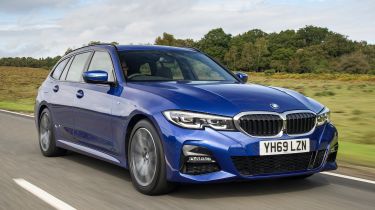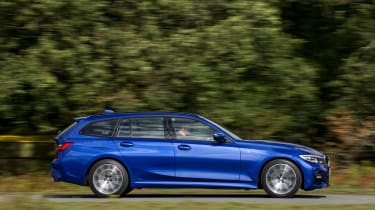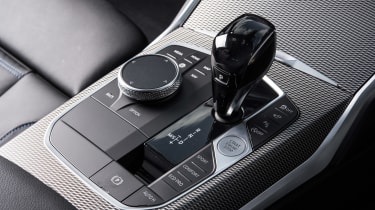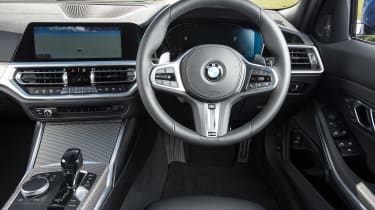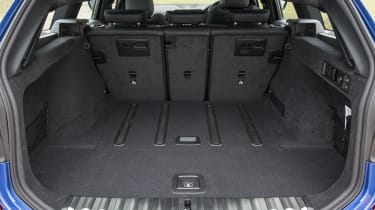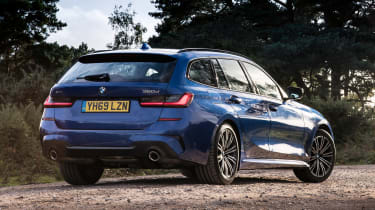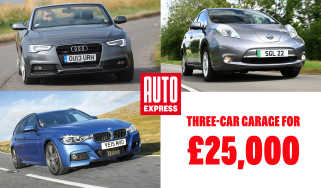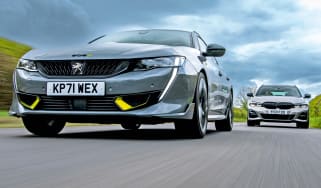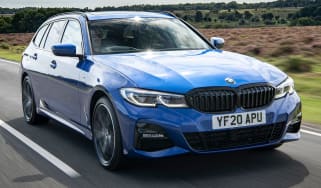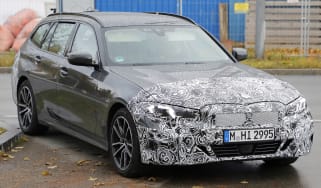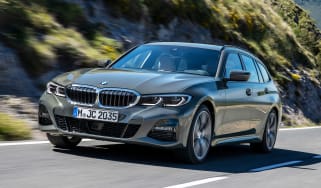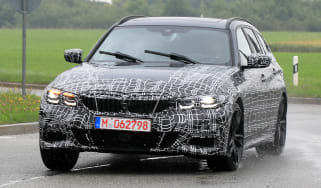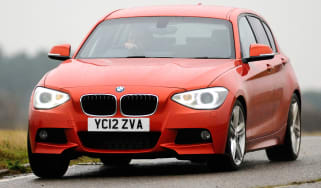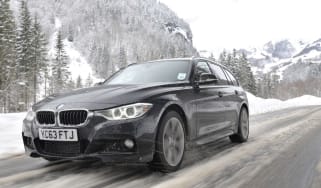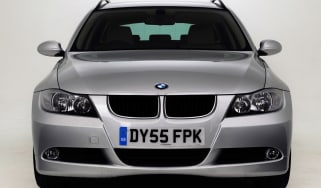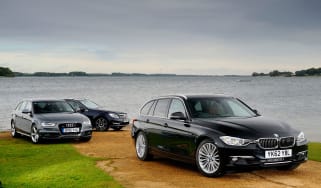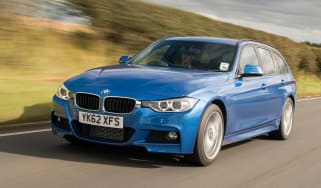BMW 3 Series Touring review
The BMW 3 Series estate takes the saloon's winning formula of performance, handling and economy and adds a large dose of practicality

BMW’s brilliant 3 Series has been a strong performer in the compact executive class for ages, boasting fun driving dynamics, strong performance, low running costs and rock-solid build quality. In Touring form, the desirable German machine adds family-friendly practicality - it's BMW's response to the Audi A4 Avant and Mercedes C-Class estate.
As with the 3 Series saloon, the Touring is the sharpest handling compact executive estate you can buy, but it doesn’t sacrifice economy in the process. Most versions are rear wheel drive, which is the enthusiast's choice for best handling, but BMW's xDrive four-wheel drive system is impressively smooth and we reckon turns the 3 Series Touring into a serious rival for the Porsche Macan and Range Rover Evoque.
About the BMW 3 Series
The BMW 3 Series Touring looks the same as the iconic saloon at the front, but features an extended roof line at the rear that’s very similar in appearance to the larger 5 Series Touring.
The result is a handsome estate car with the best boot space by volume in the compact executive class. There’s up to 1,500 litres available when the rear seats are folded. This is a marked improvement on previous generation Tourings, which were often criticised for not being practical enough. There are a number of large family cars from less premium brands that can beat the Touring’s boot space, of course, but none share its rear-drive chassis or the BMW’s upmarket aspirations.
The Touring is part of BMW’s seventh generation of the 3 Series, having gone on sale in 2019. Engine options include the entry-level 318i, the 320i, the 330i and the M340i, while the diesel line-up consists of 318d, 320d, 330d and M340d variants. There’s a plug-in hybrid 330e too, available with BMW’s xDrive four-wheel drive system. This can be had on the 320d, 330d and M-badged models too; otherwise, it’s rear-wheel drive only.
Used - available now

2022 BMW
3 Series
22,598 milesAutomaticPetrol2.0L
Cash £23,363
2021 BMW
3 Series
12,100 milesAutomaticPetrol2.0L
Cash £20,663
2021 BMW
3 Series
73,994 milesAutomaticPetrol2.0L
Cash £16,387
2022 BMW
3 Series
65,462 milesAutomaticPetrol2.0L
Cash £18,287The Touring is available in SE Pro, Sport Pro and M Sport trims, and there are also a couple of Pro Edition models that introduce a range of styling changes.
SE Pro trim is justifiably popular, as the car comes equipped with 17-inch alloy wheels, cruise control, a reversing camera, air-con, electric windows, Bluetooth phone connectivity with an 10.25-inch infotainment screen with DAB radio and sat-nav.
The Sport Pro trim adds various cosmetic embellishments inside and out, including 18-inch alloys, gloss-black grille and air intakes, plus a leather upholstery and sporty seats. The front seats are heated too. M Sport cars get their own 18-inch alloys and various exterior styling tweaks, as well as improved aerodynamics and an upgraded suspension set-up.
Engines, performance and drive
This is where the BMW 3 Series Touring excels. The front-engine, rear-wheel-drive layout is designed to entertain drivers, and the 330d in particular delivers the kind of effortless performance you’d expect, although the less potent 320d will probably serve most drivers well enough in this regard.
The six-cylinder 330d diesel engine delivers huge performance, with a significant 282bhp available on tap from the car’s 3.0-litre turbodiesel engine. If that doesn’t sound like a lot, bear in mind that 650Nm or torque will make its presence felt when you put your foot down, achieving 0-62mph in just 5.5 seconds.
However, the 2.0-litre diesel is still a decent performer and returns better fuel economy. Up to 57.6mpg is offered, whereas the 330d lags behind on 54.3mpg. For us the 320d is the pick of the range, but regardless of which engine you choose, you can be assured that you're driving one of the finest-handling family cars on sale.
If you ski, or regularly drive in inclement weather, the xDrive four-wheel drive system is worth looking at. You can expect to pay around £1,600 more for it when comparing models like for like, but if you’re unsure it still sends most of the drive to the rear wheels anyway.
However, if a slip is detected, it can send almost 100 per cent of power to the front axle very smoothly. The only downsides are an increase in weight and slight loss of steering feel.
As you’d expect, the BMW backs up its punchy performance with class-leading handling. In the previous-generation 3 Series, a combination of small wheels and softer SE suspension on Efficient Dynamics versions deliver the best ride and handling balance: this technology is now standard throughout the line-up, so all versions handle brilliantly. The steering is sharp and well weighted, while the rear-wheel-drive layout provides balanced and progressive handling.
Engines, 0-60 acceleration and top speed
The entry-level 318i petrol has a 154bhp and a 0-62mph time of 8.7 seconds. Step up to the 320i and you get 181bhp and a 7.5 second sprint to 62mph. The 330i petrol has 254bhp and cracks the sprint in 6.0 seconds dead, while the 349bhp engine in the cracking M340i does it in 4.6 seconds.
The 148bhp entry-level 318d is the slowest of the 3 Series Touring models, with a 0-62 time of 8.7 seconds. Things improve on the diesel front with the 187bhp 320d, which can manage the sprint in 7.1 seconds. However, the 282bhp 330d does it in 5.5 seconds.
330d models equipped with xDrive four-wheel drive use their extra traction to great effect, shaving that 0-62mph time down to 5.2 seconds The 335bhp M340d - the second-most potent 3 Series of the lot - hits 0-62mph in 4.8 seconds, while the M340i is the most rapid of all completing the spring in 4.6 seconds.
MPG, CO2 and Running Costs
Every engine in the BMW 3 Series Touring range comes with stop-start, which boosts fuel economy. The petrol models don’t use any form of mild-hybrid technology, although this is a standard feature on all of the diesels.
The cheapest car in the line-up is the 318i petrol, and while it’s not the most efficient it still returns an impressive 42.2mpg on the combined cycle with CO2 emissions from 152g/km.The 320i offers identical fuel economy, although these figures worsen slightly if you opt for xDrive.
The 318d is the cheapest diesel, offering up to 58.9mpg and 127g/km. The 320d diesel is once again the engine to go for though, as it delivers stronger performance, yet still manages to keep emissions down to as little as 129g/km of CO2, and economy up to a potential 57.6mpg.
Pick the 330d and you can still eke economy out to 54.3mpg with CO2 of 137/km. However, company-car buyers will be most interested in the 330e, which offers 188.3-201.8mpg on paper, with its 12kWh battery affording up to 37 miles of emissions-free range. While you’re unlikely to hit the lofty fuel economy figure in the real world, there are genuine savings to be had by using the electric capabilities as much as possible.
Furthermore, the 3 Series Touring attracts a Benefit-in-Kind rate of just 10 per cent in plug-in hybrid form. Compare that to the 320i which starts at 33 per cent and the 320d which starts at 28 per cent.
Insurance groups
All the 3 Series Touring models offer a decent level of performance, and with the prospect of premium rates charged for repairs at dealers it’s no surprise that insurance isn’t the cheapest around. Even the basic 318d falls into group 25, while the 320i is in group 29. The 330e Touring can be found in groups 34-36, depending on trim.
Depreciation
The estate carries a four-figure premium over the 3 Series saloon, although it’s not available with as many engines or trims. It is priced similarly to the Audi A4 Avant, but is slightly cheaper than the Mercedes C-Class Estate. The drop in used value over time for all cars in the class is not catastrophic compared to less premium models, with the 3 Series Touring holding onto 48-54 per cent of its original list price after three-years and 36,000-miles of ownership. The 318i petrol M Sport model is the range winner with around 55 per cent of its value retained over the three-year period.
Interior, design and technology
We reckon the 3 Series fails to attract as much attention as its sleeker rivals such as the Mercedes C-Class Estate or even the Volvo V60. Even so, the well-proportioned and neatly finished Touring is a handsome, classy-looking machine that is, to our eyes, more attractive than the standard four-door saloon.
While it’s noticeably more practical than earlier generations of the 3 Series Touring, the larger luggage area hasn’t affected the car’s ‘lifestyle’ image. That said, the kerbside appeal of some models is lost thanks to small 17-inch alloy wheels, although ironically the smaller wheels give the 3 Series chassis the most agile and engaging handling.
Buyers looking for more visual aggression will migrate towards the M Sport model, which gets a subtle bodykit, 18-inch alloy wheels and various other cosmetic changes.
Inside, the Touring looks and feels identical to the saloon model. That means you get a logically laid-out dashboard which is angled towards the driver, plus plenty of high-grade materials and impeccable fit and finish. Further highlights include the intuitive iDrive infotainment controller and the comfortable, low-set driving position.
And while the BMW’s interior can’t match the latest Mercedes C-Class for style, it is beautifully built and thoughtfully designed. The 3 Series also comes with a decent amount of standard kit. Climate control, a DAB radio and parking sensors are all included, as is a sat-nav.
Sat-nav, stereo and infotainment
Since the 3 Series was released, some BMW models – mainly its electric line-up – have moved to the brand’s latest infotainment tech. So while the 330e isn’t going into battle with the most up-to-date system, few manufacturers can rival iDrive for its simplicity, functionality and range of input methods.
The touchscreen is great to use; navigation routes can be entered via the on-screen keyboard which, although slightly smaller than the layout you'll find in a Mercedes, is still fine. Where the BMW really gains ground is with its physical click wheel controller and shortcut buttons.
Once you’ve mastered the menu structures, you can make changes on the move simply by learning which button combinations to press, all without needing to take your eyes off the road. The graphics are great on both the main screen and the standard digital dash, too.
Practicality, comfort and boot space
The driving position and front passenger space in the Touring is naturally identical to other 3 Series models, so that means it’s easy to get comfortable. The seats and steering wheel have masses of adjustment, and although the driving position is low-ish that only adds to the sporty feel.
The layout of the controls is intuitive as BMWs always are, and there are plenty of storage spaces dotted around for the family’s bit and pieces – it’s an ideal recipe for long-distance family holidays if you don’t want to drive an MPV or SUV.
Size
The 3 Series Touring has two very obvious rivals in the Audi A4 Avant and the Mercedes C-Class Estate. As the BMW has the most luggage space, but sits in between the two rivals at 4,709mm in length – the A4 is 4,725mm and the C-Class 4,702mm. The trio are very similar in terms of width, and only not far apart on roof height either.
Leg room, head room & passenger space
The current 3 Series Touring is a big improvement of the previous model in terms of space in the rear: the longer roofline means there’s plenty of headroom for adults, while kneeroom is plentiful too. As such, young family members will have no problems at all.
There are ISOFIX mounting points for a pair of child seats, which you can access quite easily as the doors are reasonably sized.
Boot
Compact executive estates aren’t designed for maximum carrying capacity, but the BMW 3 Series Touring performs well. The 500-litre boot is just five litres shy of the Audi A4 Avant’s and 40 litres bigger than the Mercedes C-Class’s.
Unlike the 3 Series saloon, the Touring has a folding rear seat that splits 40:20:40, so the boot is very versatile. With everything folded down, the load space grows to a very decent 1,510 litres.
Other useful items include lashing hooks in the floor, bag hooks, a folding floor divider, cargo net, plus extra hooks so you can divide the boot from the interior whether in five-seat or two-seat modes.
All cars come with a powered boot lid as standard. As the BMW comes with run-flat tyres, the space that would be taken up by the spare can be liberated to create a deep hidden compartment beneath the hinged boot floor.
Reliability and safety
The 3 Series finished in 31st position out of a 75-car list in our 2021 Driver Power satisfaction survey, while BMW itself came 21st out of 29 manufacturers - an improved result compared to 2020's 27th place, but still not good enough for such a premium brand.
The safety picture is much more positive, as although the Touring model hasn’t been independently tested, the 3 Series saloon on which it is based has been awarded a five-star Euro NCAP rating. Like the saloon, the Touring has a full suite of airbags, plus stability control and tyre pressure warnings as standard. The useful rear parking sensors are standard, too.
A full range of safety-related extras is on offer via the comprehensive options list. However while lane-keeping assistance and blind spot warnings are not to be sniffed at, it’s worth asking yourself if you really need them as they can quickly bump up the price. Front collision warning, lane departure warning and speed limit assistance are all standard features already, after all.
In contrast, the optional head-up display, which projects key driver info into the windscreen, is very useful and means you never need to take your eyes off the road. Whether or not you want to pay for BMW’s Technology Package at £1,900 is another matter.
Warranty
While the standard BMW warranty cover is only three years, the company offers it with the major benefit of unlimited mileage. Audis are limited to 60,000 miles over the same three year period, but Mercedes offers three years/unlimited mileage cover on its cars, just like BMW.
Servicing
With a range of fixed-price servicing plans, the 3 Series Touring should be relatively affordable to maintain. However the jury is out on the variable service intervals, which mean you can go up to two years without an oil change. While ideal for fleet managers who only keep cars for two or three years, we’d understand private owners wanting more frequent changes.
